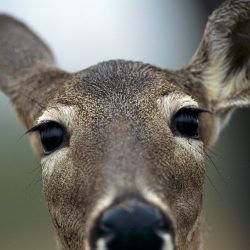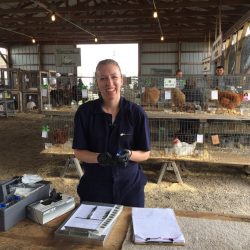Matt Kuhn is a fourth-year DVM and Medical Science Training Program (MSTP) dual-degree student. Kuhn was recently awarded the MSU Council of Graduate Students Disciplinary Leadership Award. This award recognizes Kuhn’s demonstrated leadership in and dedication to MSU’s DVM and MSTP degrees.
It may surprise you to know that the closest veterinary school to Michigan State University is not in Ohio, Indiana, or Wisconsin; MSU’s closest veterinary neighbor is not even in this country, but rather across the St. Clair River in Guelph, Ontario. It’s here at the Ontario Veterinary College (OVC) of the University of Guelph, Ontario, that each winter, four students from MSU and OVC meet to take on a clerkship that teaches students to find practical solutions to the problems that farms face while exposing them to the dairy industry of their international neighbor.
The clerkship is led by Dr. Lou Neuder and is called the Ruminant Health and Problem-Solving Clerkship. The participants spent a week each in Canada and the United States. In both countries, we witnessed the real-life problems that local farms are confronted with. These issues range from the increased rate of calf pneumonia to reducing on-farm antibiotic use. Working in a different country certainly added complexity to our task.
The disparity between our two countries’ dairy industries stems from the Canadian government’s milk quota system, which helps support milk prices. This has allowed smaller farms to remain profitable. To illustrate the difference, the average number of cows on a farm in Ontario is approximately 85. In contrast, the farms we commonly work with in Michigan have approximately 3,000 cows. There also are smaller differences that we were forced to confront, such as the availability of specific pharmaceuticals in one country, but not the other.
Stretching our minds to solve problems while being in an unfamiliar country and learning to follow new methods and models, was an extremely valuable experience. The international collaboration associated with this rotation was key to its success in our minds.
As students in the fourth and last year of our DVM programs, each of us have completed several clerkships that focused on various aspects of herd-level problem solving. As a capstone project, this rotation required amassing these skills to diagnose and solve the problems at hand. Using a mixture of records analysis, “boots on the ground” observation, and a surprising amount of statistics, each farm’s problems were defined, detailed, and put into a fiscal perspective. Ultimately, each farm and herd veterinarian were presented with practical solutions customized to fit their farm and management style.
I can’t help but feel the need to boast about what a fantastic opportunity this is for students at MSU and as well as show off the international collaboration it represents.
There was a consensus amongst students that the Ruminant Health and Problem-Solving Clerkship was among the best in our clinical years. Part of this is owed to the strong camaraderie that was built between students from both schools in a short period of time. Another part stemmed from the opportunity to learn clinical skills from some of the most accomplished veterinarians in the United States and Canada.
But what really stands out as a key factor that made this clerkship such a success for us veterinary medical students was the self-validation of our knowledge and skillsets. For the first time, we felt like real veterinarians. Our work was about more than just reading a case study; the problems we faced were real, impacting real animals and real people. Our conclusions would influence the health and well-being of hundreds of animals and, ultimately, the bottom-line of hard-working farmers. It brought about a different sense of responsibility in us and, accordingly, a tangible sense of accomplishment and confidence.



